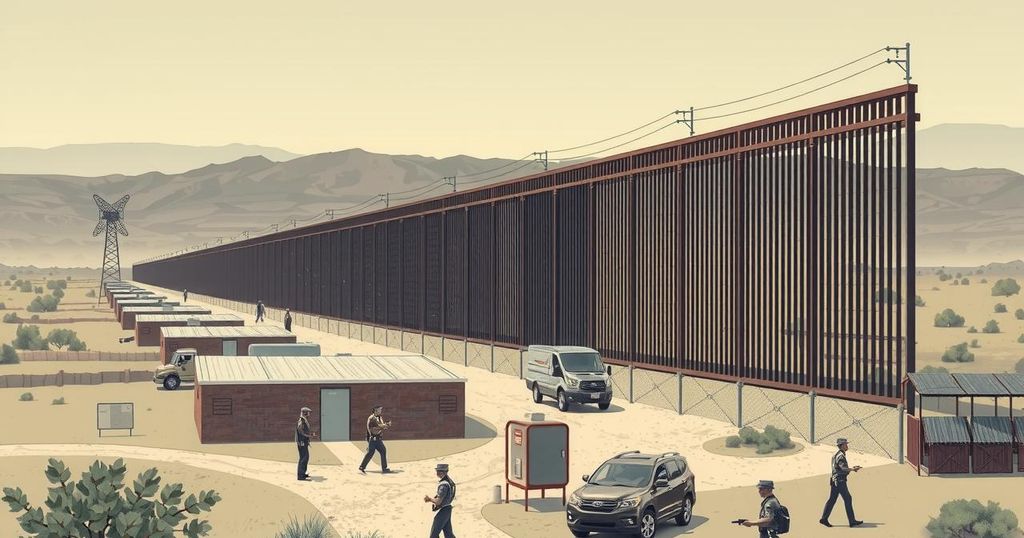World news
2024 PRESIDENTIAL ELECTION, ADAM ISACSON, AMERICA, ASIA, CONGRESS, CUSTOMS, DONALD TRUMP, HOMELAND SECURITY, HOUSE, HOUSE HOMELAND SECURITY COMMITTEE, IMMIGRATION, IMMIGRATION AND CUSTOMS ENFORCEMENT, LA, LEGISLATION, LOS ANGELES, MEXICO, MIKE JOHNSON, NORTH AMERICA, PHILIPPINES, POLITICS, SENATE, TRUMP, TRUMP ADMINISTRATION, U. S, U.S. ELECTIONS, UNITED STATES, WOLA
Oliver Grayson
0 Comments
Four Ways Trump’s Big Bill Could Change the U.S. Immigration System
President Trump’s immigration bill could inject $150 billion into enforcement efforts, expanding the southern border wall, increasing detention capacities, and resulting in higher immigration fees. Despite its potential, concerns remain about vagueness in funding allocation and the broader implications for immigrant rights and management of the court system. The Senate’s ongoing discussions highlight a contested political landscape ahead.
President Donald Trump is pushing forth a significant bill estimated to cost around $150 billion, aimed at reshaping the U.S. immigration landscape. This bill includes initiatives like extending the southern border wall, establishing more detention centers, and increasing law enforcement personnel. Currently, immigration enforcement, primarily handled by ICE, operates with a budget of about $10 billion. A bill of this magnitude would essentially transform America’s immigration system while potentially raising the costs associated with entering the country legally.
As discussions unfold in the Senate regarding their version of the bill, lawmakers are facing urgent calls, especially from Republicans, to expedite the process despite Democratic resistance. Recent protests, particularly those in Los Angeles, have intensified the rhetoric surrounding immigration reform. House Speaker Mike Johnson emphasized the need for immediate passage by stating, “The lawlessness happening in LA is ANOTHER reason why we need to pass the One Big Beautiful Bill IMMEDIATELY.”
While the specifics of the bill remain quite broad, experts are raising concerns. Adam Isacson from the Washington-based organization WOLA pointed out that, “these sections are super vague,” underscoring a lack of clarity in how funds will actually be allocated. This kind of ambiguity raises questions about the bill’s implications and accountability.
One of the bill’s major highlights involves funding approximately $46.5 billion for an integrated border security system, which encompasses various physical barriers like walls and technology at the southern border. Lawmakers like Rep. Mark Green from Tennessee stressed that those advocating for border security would have to offer support for these recommendations. However, the effectiveness of such barriers is contentious, with past experiences suggesting that illegal crossings could shift rapidly.
Another $45 billion is earmarked for expanding detention facilities and staffing. This includes plans to double current detention capacity to 100,000 beds and an additional investment in more than 12,000 new ICE and Border Patrol agents. The intention appears to anchor a system capable of expediting deportations. Critics note that while the bill represents a push to ramp up deportation numbers, it raises concerns about reliance on the private prison industry, whose stock has surged since Trump’s presidency.
The immigration court system is also in the spotlight, with a proposed allocation of $1.25 billion to address its severe backlog of over 3.6 million cases. Currently plagued by chronic understaffing—about 700 judges are handling an overwhelming number of cases—this infusion would ideally help streamline the judicial process. However, it also reflects potential administrative tactics to curb the judicial aspect of immigration.
Accompanying the bill is an overhaul of immigration fees, suggesting an increase in costs that historically have been free. Asylum seekers, for instance, now would need to pay $1,000 just to apply, with additional fees for work permits and appeals. This places an economic burden on many, pushing legitimate applicants to rethink their options and plans.
In sum, while Trump’s proposed bill aims to fundamentally change the immigration rules and enforcement in the U.S., its contours are marked by vagueness and controversy. Experts continue to dissect its potential impacts, raising flags about feasibility, intentions, and the real-world effects on those seeking life in America. The political landscape surrounding this bill remains volatile, and its future appears uncertain as the Senate deliberates its path forward.
In conclusion, President Trump’s proposed immigration bill could significantly alter the landscape of U.S. immigration policies and enforcement practices. Relying on substantial financial streams, the bill aims to expand border security measures and detention systems while increasing costs for applicants. As the Senate debates, the ambiguity surrounding the bill’s specifics raises questions about its implementation and the potential repercussions for immigrant communities. With key areas like detention, courts, and immigration fees in the mix, the outcome could shape migration policies for years to come.
Original Source: www.pbs.org




Post Comment